

December 2014
Star Formation in Scorpius
ESO's Atacama Large Millimeter/submillimeter Array (ALMA) in Chile has been imaging a new star being formed in the Scorpius. What they have found will have to rewrite the existing theories.
At the center of a star forming region is an object known as G345.4938+01.4677. It is a very young star in the process of forming as the cloud collapses under gravity. The new star is about 15 times more massive than our sun. The astronomers discovered there is a large disc of gas and dust around the forming star as well as a stream of material flowing out from it. According to existing theories, there should be no stream nor disc around the star because the strong radiation from massive stars should push the material away.
The theories state that the ultraviolet radiation from a massive star would destroy the molecular gas and dust and create ionized gas. As the gas and dust are thought to impede a star's growth, it was theorized that smaller stars cannot destroy the gas and dust and thus remain smaller stars, but massive stars would have enough radiation to destroy the gas and dust. These new discoveries show this theory to be wrong.
Three major discoveries were made by ALMA observing this new star being formed. The first being that a supersonic stream being formed inside the ionized gas region was emerging from the star. This suggests it survived the ultraviolet radiation.
The second discovery was first-time evidence of the effect of electric fields on the hydrogen emission lines.
The third discovery is of molecular gas and dust rotating around the star. This shows that even high mass stars form a protoplanetary disc. In this case, the dynamic is dominated by the mass of the disc instead of the star.
In the photo below you can see in the enlargement insert the star itself. This is the bright red spot near the center. From there you can see the cavity created by the jet stream flowing out to the left of the star.
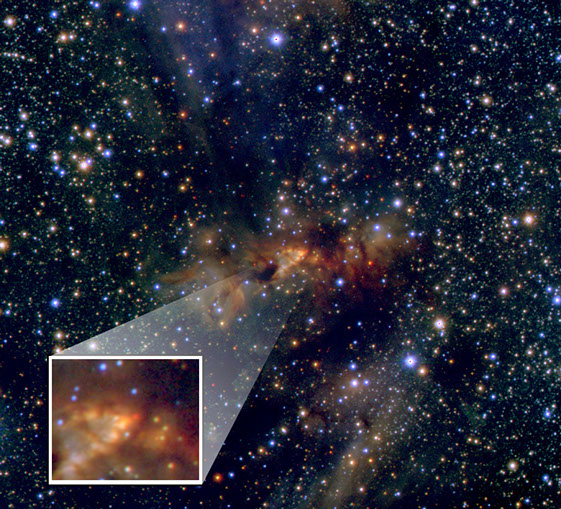
Image Credit: ESO/VVV Team/A. Guzmán
Galactic Merger
The Atacama Large Millimeter/submillimeter Array (ALMA) in Chile has discovered the best evidence yet for galaxies merging in distant protoclusters. ALMA observed the galaxy AzTEC-3, located more than 12.5 billion light years away. AzTEC-3 is producing stars at a rate of 1,000 times faster than our Milky Way. Around AzTEC-3 lay three young calmer galaxies. Astronomers believe they are seeing the best evidence that energetic galaxies grew from the merger of smaller ones in the early Universe.
In the early Universe, energetic galaxies produced stars at extremely high rates. The galaxies merged with other galaxies. Over the billions of years, large galaxies and galaxy clusters formed.
AzTEC-3 cannot be seen well in the optical and infrared wavelengths because of the dust from the high level of star formation. But astronomers are able to view it in the submillimeter wavelengths. Since AzTEC-3 is 12.5 billion light years away, we are seeing it as it appeared back then, not long after the Big Bang.
AzTEC-3 has very little rotation, suggesting that is probably recently merged with another galaxy which disrupted its motion. The three other galaxies appear to be part of the same system but not yet gravitationally bound. In this state it is called a protocluster, not quite yet a complete galaxy cluster.
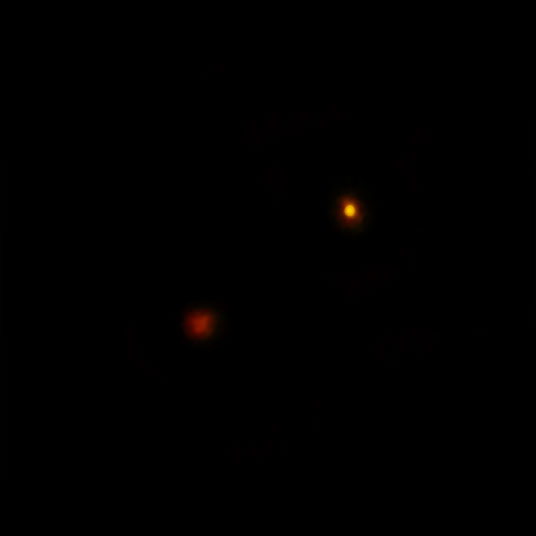
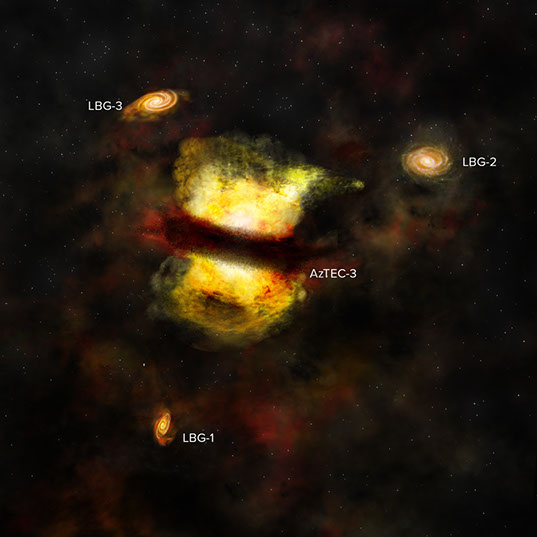
(Top Photo) ALMA image of AzTEC-3 (upper right) and galaxy LBG-1 (lower left).
Credit: ALMA (NRAO/NAOJ/ESO); B. Saxon (NRAO/AUI/NSF)
(Bottom Photo) Artist concept of protocluster.
Credit: B. Saxon (NRAO/AUI/NSF)
Visit our sponsors.


For advertising opportunities on this page and our videos, contact
Upcoming Launches
Date: December 4
Launch Vehicle: Delta IV
Launch Site: LC 37, Cape Canaveral Air Force Station, Florida
Description: Flight test of NASA's new Orion Spacecraft
Date: December 16
Launch Vehicle: Space-X Falcon
Launch Site: LC 40, Cape Canaveral Air Force Station, Florida
Description: Space-X CRS-5 to deliver crew supplies and instruments to the International Space Station.
Globular Cluster Mystery
Where are the missing stars? A new mystery surrounding globular clusters has arisen from the latest Hubble Space Telescope data.
NASA's Hubble Space Telescope has been looking at globular clusters in the Fornax Dwarf Galaxy. They have discovered that the globular clusters there appear to be identical to globular clusters found in the Milky Way. This implies that globular cluster formation is the same in different galaxies. But this poses a problem with a leading theory.
Globular clusters were once thought to contain stars that were all born about the same time. But today we know that there were two separate populations. The second generation of stars in the clusters contain up to 50 to 100 times more nitrogen than the first. The number of second generation stars is also much higher than the first.
The leading theory suggests that a large amount of the first generation stars were ejected from the cluster. This would account for the difference in population proportions between the generations. In the Milky Way, the ejected stars can easily be assumed to be with other old stars in the halo. But in the Fornax clusters this cannot be the case.
The Fornax clusters also contain two generations of stars made up with the same differences in nitrogen as those clusters found in the Milky Way. The population proportions between the generations are also the same. But the Fornax galaxy does not have enough old stars to account for any stars being thrown out of the cluster. If first generation stars were thrown out of the clusters in the Fornax galaxy we would see them.
Scientists will now have to revisit why there are differences in the generations of stars in globular clusters.
Globular Cluster Fornax 3 in the Dwarf Galaxy Fornax
Credit: NASA/ESA/S. Larsen (Radboud University, the Netherlands)
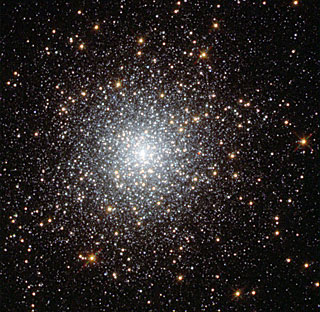
Van Allen Belt Barrier
The Van Allen belts are charged particles collected together by Earth's magnetic field. The inner belt stretches from 400 to 6,000 miles above the Earth and the second from 8,400 to 36,000 miles above the Earth. They move in response to incoming radiation from the sun. Sometimes the belts can swell putting low-Earth orbit satellites in danger from radiation. By understanding how the belts work. scientists can help protect these satellites from harm.
In 2012 NASA launched its Van Allen Probes which are now helping us understand the belts in detail for the first time.
The inner belt is made up of mostly protons. The outer belt is made up of energetic electrons. But what causes the gap in between them? The Van Allen Probes have discovered a barrier that is impenetrable, blocking out even the fastest moving electrons. But what causes the barrier? They looked at various possibilities.
The first possibility was human generated. This was dismissed. The second was physical, the shape of the magnetic field. This was also dismissed. It was determined that some other space particle was at play.
The Earth has another particle structure surrounding it, the plasmasphere. The plasmasphere is a large cloud of cool charged particles and fills up most of the outer atmosphere starting at about 600 miles above the Earth and going out to near the outer edge of the outer Van Allen belt.
The particles of the plasmasphere cause the particles in Van Allen belt to scatter, but the effect is fairly weak. Normally, the interaction of the two would not be enough to keep the electrons in place. However, the radiation belt electrons move very quickly in giant loops around the Earth, but their movement toward Earth is slow slow and gentle. The motion towards Earth is so weak that the plasmasphere is much stronger in comparison and acts as a barrier. During a large solar disturbance, the outer Van Allen belt can actually move into the usually empty space between the two belts pushing into the plasmashpere.
Scientists continue to study and analyze the data from the probes to help understand how these radiation belts work, what impact they have on the atmosphere and ozone layer, and learn more about the magnetic fields and plasma that make up most of the Universe.
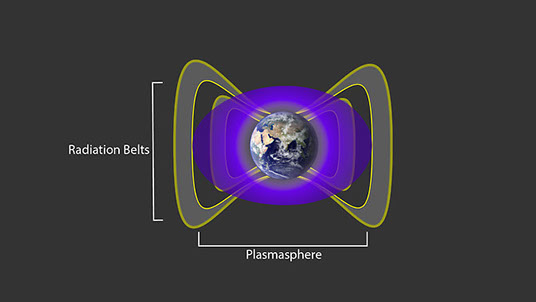
Van Allen belts are shown in yellow/grey and the plasmasphere in purple.
Credit: NASA/Goodard
Quasar Alignments
Quasars are energy produced as something is sucked into a supermassive black hole. Supermassive black holes are found a centers of galaxies. As material falls into the black hole, long jets of hot material are shot out into space along the black hole's axis of rotation. These are quasars. It is believed quasars were at the center of all galaxies early in the Universe as the galaxies were young and the black holes at their centers had plenty of material to feed on.
A team from the University of Belgium used ESO's Very Large Telescope (VLT) in Chile to study 93 quasars that were active when the Universe was about a third of its present age.
The team discovered that some of the quasars were aligned to each other even though they were billions of light years apart. This prompted them to examine the rotation axis of the black holes.
In the early Universe, galaxies were not equally distributed but instead form a cosmic web of filaments around areas of empty space. This is known as the large-scale structure of the Universe.
The results from the VLT indicate that the quasars tend to be parallel to the large-scale structures along the filaments. This means the black holes would have to point along the the direction of the filaments.
The probability of this being a result of chance is less than 1%. The results indicate these alignments are on a greater scale than previously imagined and hint there may be something missing from our current models of the cosmos.
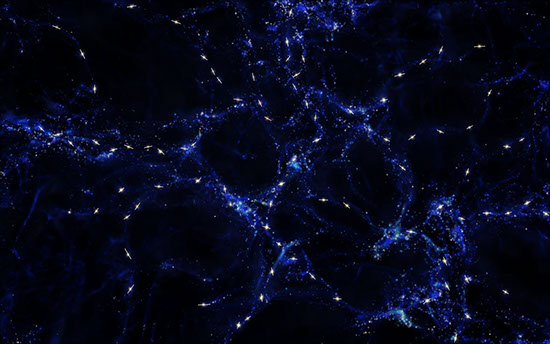
Artist Impression of large-scale structure. Quasars are in white with the rotation axis of the black holes. Alignments are billions of light years apart. For illustration purposes only - does not depict actual distribution of galaxies and quasars.
Credit: ESO/M. Kornmesser
Rosetta Science Continues
Despite the fact that the Philae lander's batteries cannot get enough sunshine to recharge and the landing part of the mission is finished, Rosetta itself continues to gather science.
On 3 December the spacecraft will move down to an altitude of 20 km above the surface for 10 days. it will then return to an altitude of 30 km. During this time Rosetta will collect gas, dust and plasma as well as map large parts of the nucleus at high resolution.
As the comet moves closer to the sun, Rosetta will be the first spacecraft to study up close the effects of the sun and what activity takes place. The comet makes its closest approach to the sun on 13 August 2015, 186 million kilometers from the sun. Rosetta will be able to move between orbits if activity on the comet increases as the comet nears the sun.
As for Philae, attempts to get a signal will take place periodically. As the comet gets nearer the sun, illumination on the surface will increase and it may be enough to recharge the batteries, although this is far from certain.
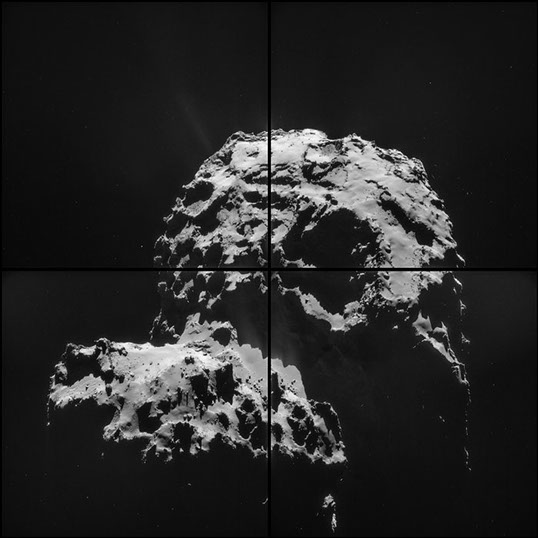
Montage of four photos taken 30.2 km above the surface of Comet 67P/Churyumov-Gerasimendo on 30 Nov 2014.
Credit: European Space Agency (ESA)
© 2014-2016 Ted Cook Productions LLC. - All Rights Reserved